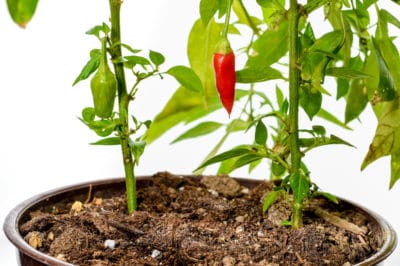Potting Soil
A high-quality potting soil is a key to healthy container veggies. No plant will survive well in compacted or waterlogged dirt. make sure your potting soil is fluffy and well-draining while maintaining the capacity to store plenty of water. Purchase an all-purpose organic potting soil, or mix one yourself by combining the following ingredients in equal parts.
- Peat or Coconut Coir
- Screened Compost or aged manure
- Perlite or Vermiculite
For hot peppers specifically, adding 1-2 tablespoons per gallon of ground eggshells to the potting mix will boost the calcium levels and prevent blossom end rot.
Watering
Plants in containers will need more water than plants in the ground. Check the pot daily to see if it is dry. If you can stick a finger into the soil to 1-inch deep and it feels dry then water thoroughly.
After some weeks of observation, you will know approximately how long between waterings. Stick to a regular schedule and avoid over or under watering. Peppers become susceptible to disease when over or under watered.
Temperature
Next to the potting soil, keeping hot peppers in their ideal temperature range is a huge component of success. Peppers need to be between 65-75°F (18-23°C) in order to avoid stunting.
Plants will stunt if exposed to extreme temperatures or fluctuations. Growth will severely slow or stop completely, and the plant will not produce or get bigger. Stunted plants can return to normal, but it can take months.
Light
Peppers like full sun, which is 6 hours per day. If you can take your container outdoors during the warm season, natural sunlight is the best light they can get. Otherwise, placing it in a window where it will get plenty of direct light will work. If you’d like to perennialize your potted plant, you may need to supplement it with artificial light through the winter.
Staking
Hot pepper plants grow 2-4 feet tall and can have long gangly arms that need support. Keep in mind while choosing your container and location that you may need to insert or build a small trellis or support cage around the plant to keep it upright.
Warning
If you are growing really hot peppers indoors, keep in mind they produce compounds that are irritable to the skin, eyes, and throat. Pets or children can be affected simply by passing by a ghost pepper plant.
